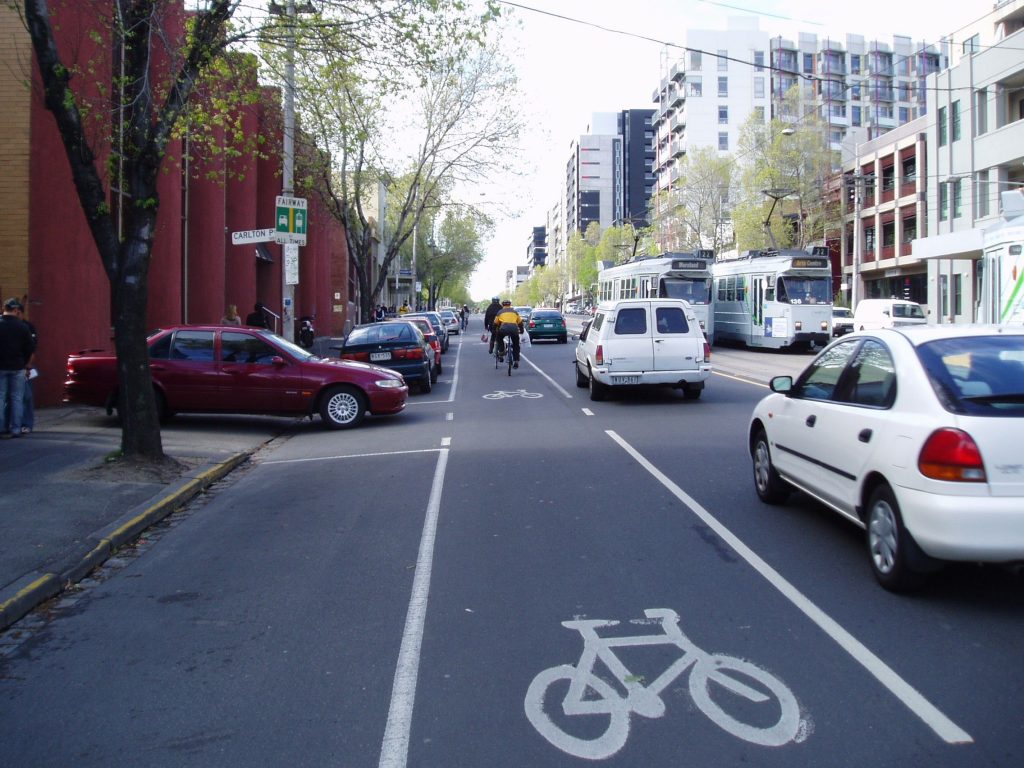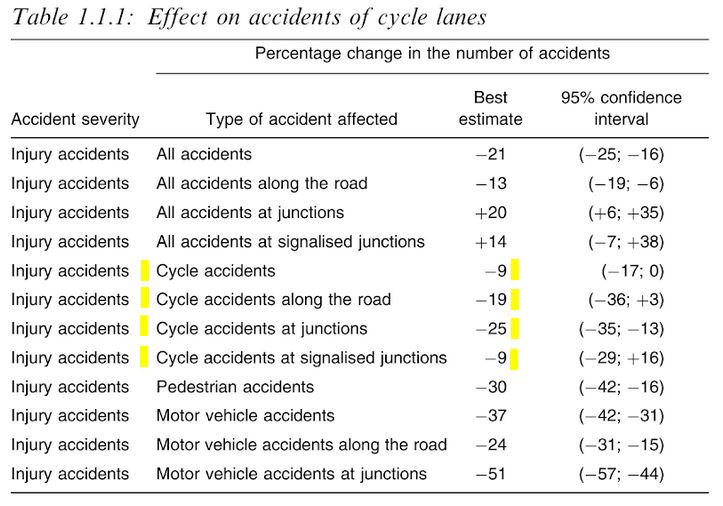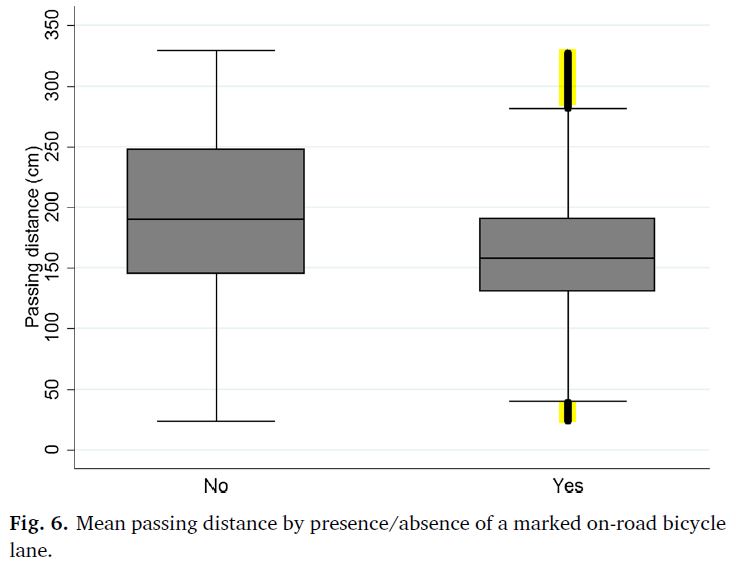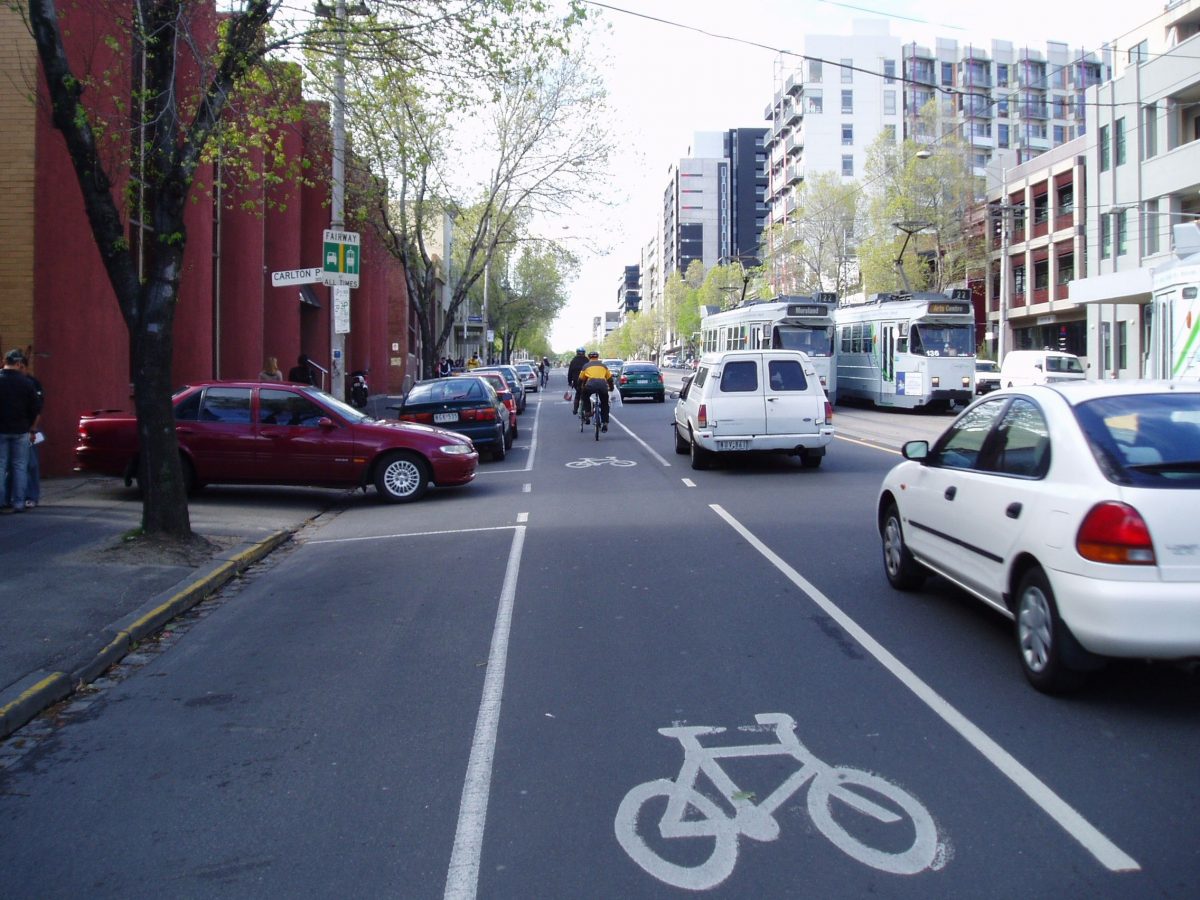A recent news article (and similar variants) has been doing the rounds recently and sparked a lot of social media comment. The article reports on some recent research from Australia that measured the space given by motorists passing people cycling. The piece of the study that caught the attention of the media was that the average passing distance recorded when biking in a painted cycle lane was 25-40cm less than when biking on a road without one.

The inference that many people seem to have jumped to is that cycle lanes are therefore worse than having nothing marked. Given that some people seem to hate on-road cycle lanes with a vengeance, this is perhaps not surprising. But the reality is a bit more nuanced than that…
Firstly it is important to appreciate that a reduction in mean passing distances does not necessarily correlate with a reduction in actual cycling safety. Indeed, the opposite has generally been found when before/after safety evaluations of painted cycle lanes have been done. As reported here previously, there is reasonable evidence internationally and locally that installing painted cycle lanes can reduce cycle crashes.

A good summary of international evidence is the Handbook of Road Safety Measures (2nd Edition, 2009, edited by Rune Elvik, Truls Vaa, Alena Hoye, & Michael Sorensen). This found that the best estimate of the reduction in cycle injury accidents after installing on-road cycle lanes was about 9-25% (interestingly, greater savings from cycle lanes are found for other travel modes). Most studies hadn’t controlled for the numbers of people cycling either, and typically cycle numbers increase along routes with new cycle lanes.
Locally, a useful study looked at before/after crashes along 12 new cycle lanes built in Christchurch, and allowed for changes in cycle volumes too (disclosure: I supervised the researcher). That study found a 23% average reduction in cycle crashes; it should be noted that the cycle lanes constructed were generally industry best practice in terms of widths.
So how come passing gaps are getting smaller with cycle lanes? This is not the first study I have seen to show this effect. I suspect what is happening is that both driver and rider are feeling more certainty in their positioning with a line between them. Without a line, people are generally playing it conservative in guessing the gap – of course the safety problem is from the few who don’t leave much/any gap…
This is backed up by the details of the Australian study that most people have failed to mention: the observed variation of the distances around cycle lanes (as measured by the standard deviation) was less than that for the non-cycle lanes. And the lowest observed gaps? They were recorded on the sites without cycle lanes…

Now I absolutely understand that a mere painted cycle lane will do little to attract all the new “interested but concerned” audience to bike more; bring on more of the quiet streets and separated bikeways where possible. But let’s do away with this nonsense that a painted cycle lane (using best-practice design) is worse than doing nothing. In terms of your existing cycling population at least, on-road cycle lanes are very beneficial and can still be a very cost effective part of your cycle network.
What do you think? Does passing distance matter? Or are actual collisions more important?


I’d love the cycle lane on Wainoni Road to continue further and onto Kerrs Road. The moment the cycle lane, ends the feeling of vulnerability increases significantly.
Given that drivers are required to keep left it is no surprise. I thing most drivers just drive along not fully conscious of what they are doing. On most major open roads there is a white line on the left just before the shoulder so they are so used to sitting right on that white line as they want to stay away from the centre line. So when they encounter the solid white line of a cycle lane they do the same thing. Roads vary in width and I am often left thinking: why is that driver so close to me when they have a number of feet between them and the centre line.
Ironically when I am driving a Motor Home on the open road and large trucks are coming towards me only inches from the centre line I think: what the heck he has a good couple of feet on his left, wtf don’t they move over a bit.
Hi LennyBoy, I think there’s a lot we could do to get a quick and dirty cycle network up and running in our cities and then improve it with well-targeted more expensive treatments as we can. So the concept of using painted lanes isn’t something I’m fundamentally opposed to. I have a few question marks about this, though. In your original article reporting Glen’s research, you say, “Note that I said “well designed” – fortunately most of Christchurch’s cycle lanes have been provided with industry best-practice widths and layouts (although we can all think of a few pinchpoints…)”
Glen’s research is of Christchurch, which does have wider lanes, and generally lower traffic volumes than we do in Auckland. We’ve got some cheap and nasty painted lanes here… A quick comparison of my locals – the cycle lanes on Carrington Rd, Auckland – with the ones that appear on the Lincoln Rd shot, show that
– instead of about 1.59m cycle lane width in Christchurch, we have 1.34m, reducing to less than 1m around corners
– and the traffic lanes are 3.24m cf the Lincoln Rd lanes of 3.41m.
The highest AADT I’ve seen for Carrington Rd are over 25,000 vpd (although lower currently, but they’ll rise again). I don’t know what they are now on Lincoln Rd, but it seemed to be 14000 vpd in 2011.
I think the closer passing distances probably apply to the Auckland situation as well… but because the traffic lanes are narrower to start with, the closer passing distances probably become very dangerous. And then the cycle lanes are narrower too…
Given that we _don’t_ have industry best-practice widths and layouts… do you think we’d be best just to go with the Australian research as being more appropriate for Auckland? And could the Australian research be support for submitting against such narrow lanes – even though submitting against any cycling infra goes against the grain?
What this seems to suggest is that if you build crap infrastructure, you will get crap results; conversely if you build good infrastructure you should get better results. It’s all very well asking for protected cycleways instead of cycle lanes, but if there wasn’t room (or desire) to put in a proper painted cycle lane, why would there be room/desire to do a good job of a separated one? Either way, we need to consistently push for appropriately good design standards of all cycling infrastructure (and that might mean removing a parking/traffic lane, narrowing other lanes, or adjusting kerb lines to achieve it).
Agreed – crap infrastructure lets the anti-cyclist say “we spent money on lanes and you don’t use them so why would we allocate more?”
Yes, I’m digging into the research released this month about parents giving licence to their kids to travel independently (or not, as the case usually is) in Auckland. Most of the findings were intuitive (although the second one is really good to hear! We’re not being overprotective!)
Key findings were:
(1) parents identified a need for safer traffic environments for their child’s independent mobility;
(2) no significant differences were observed between objective neighbourhood built environment measures and parents’ reported neighbourhood needs; and
(3) parental licence for their child’s independent mobility was positively associated with parent perceptions that dedicated and safer places to bike were needed in their neighbourhood and negatively associated with residing in an area with a higher ratio of cycle path to road lengths.
The second half of number 3 is fascinating though. In Auckland, although parents want dedicated cycling infrastructure, they are less likely to let their kids cycle where there is some! I checked with the researchers that this is correct, and it is. I’d hypothesise:
– the cyclelanes are generally only provided in areas where traffic is busier, so those are the places parents are unlikely to want to let their kids cycle anyway (due to traffic volumes and speeds)
– our painted cyclelanes are so unsafe for kids that parents would prefer them not to cycle independently because they might be so silly as to use them.
Good stuff today on Greater Auckland about how much nicer the Christchurch people were about Lime… for the same reason probably. Your roads and footpaths are wider, with fewer people.
Hi,
The infrastructure changes to the the design of any traffic-able route are important, obviously. ‘Any‘ means from planes to trains to wheelchair walking tracks.
I’m a bit late replying to this article, I’ve only been back in Christchurch riding for about 6 months.
Two things I can say with certainty of Christchurch – First, it’s safer to ride in Sydney in peak hour in areas with high traffic flow that can still make the speed limit, and second, Christchurch drivers are more likely to be ignorant/rude/selfish towards anyone else on the road.
I actively avoid 2-3 instances where I would get hit by a car weekly, and another 1-2 where I can’t avoid. I get physically nudged or forced off the road into a parking or other space (gutter/footpath/traffic island) and drivers sometimes apologise, but mostly they just shrug… they don’t give a £*&t!
Painted cycle lanes are barely better than nothing.
Example https://youtu.be/7w7PeN-Di6c
You’re always going to get motorists who don’t know how to drive! I believe that the white line(s) are a much better alternative to dedicated cycle lanes separated by kerbing from the main roadway.
The second sentence seems to directly contradict the first one. Physical separation will be a better protection against human error than paint.